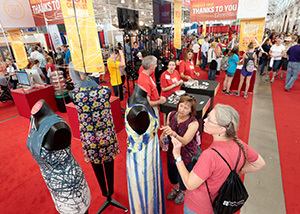Making quick work
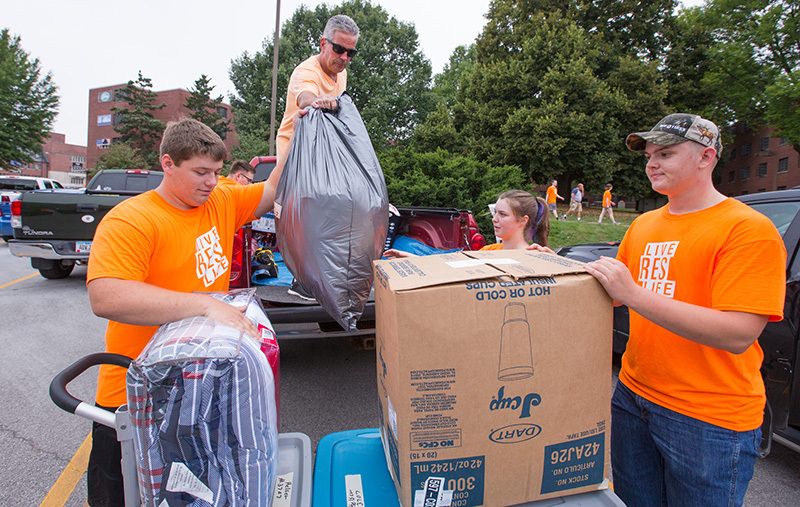
Photo by Christopher Gannon.
A volunteer student crew helps Cyclone dad Scott Olson of Minneapolis unload his truck outside Helser Hall Tuesday morning during the residence department's well-orchestrated new student move in. About 560 returning students volunteered Tuesday and Wednesday to assist with transporting student belongings from car trunk or trailer to residence hall room. All told, the volunteer teams moved in 4,652 students.
How, and why, to see the total eclipse
Steven Kawaler has been looking forward to Monday since July 10, 1972.
That's the day the Iowa State astronomy professor, then a 14-year-old at astronomy camp, saw his first total solar eclipse. He caught a few seconds of totality -- the moment when the moon is completely blotting out the sun -- before the clouds rolled in. And those few seconds caught the self-assured teenage scientist by surprise.
"I was convinced I would be looking at this thing with an analytic view and be enjoying it for the rarity of the event. But it got scary. It really did," Kawaler said. "The fight or flight reflex was starting to rear its head. What if the sun doesn't come back? Do I need to go someplace safe? Do I need to store food? That kind of thing."
Seven years later as an undergraduate, Kawaler's second total eclipse came with sunnier skies. He didn't figure he'd have the same reaction. He was wrong.
"You, as a living entity, come to expect the sun when it's up in the middle of the day not to go anywhere," he said. "Even though you know precisely what is happening and can do the calculations to predict it even, which I could by that time, you still feel this combined sense of dread and wonder."
Since then, Kawaler has realized the power of the sight of a disappearing sun. Colleagues who have seen a dozen have told him they get the same feeling every time. "There's no way around it. It's one of the wonderful things about how the human mind -- and maybe soul – works. It recognizes the uniqueness of this event," he said.
Kawaler hopes as many human minds as possible recognize the uniqueness of the event Aug. 21 and make plans to travel a few hours southwest, where the coast-to-coast path of totality will clip the southwest corner of Iowa as it passes about an hour south of Omaha and just north of Kansas City. It will be the first total solar eclipse in 99 years to track across the continental United States and the first visible in any part of the lower 48 since 1979.
Here are a few things to know, courtesy of Kawaler and Charles Kerton, associate professor of astronomy.
Don't look
Don't gaze directly at the eclipse -- other than the couple minutes at most of totality, which won't happen in Ames -- unless you have specially designed glasses. It can cause serious eye damage.
Several local retailers have been selling the glasses, though they might be sold out. Be sure to confirm glasses are made by a reputable manufacturer. A safe pair should be so dark normal light doesn't shine through them. Otherwise, there are numerous ways to project an image of the eclipsed sun with a homemade pinhole camera.
Just try
Yes, it's on the first day of fall classes. Many hotels and campgrounds along the path have been booked for years. The traffic will be epic.
But the difference between spotting a partial solar eclipse and experiencing a total solar eclipse is like the difference between reading a recipe online for Kraft macaroni and cheese and having Gordon Ramsay cook a three-course meal in your kitchen, Kawaler said.
"Try to see it. You've got to try," he said.
Partial plan
If you can't travel to see totality, make plans to see the partial eclipse.
In the Ames area, the eclipse will begin in the southern sky at 11:42 a.m., as the curve of the moon begins advancing across the sun from the upper right. The peak locally will be at 1:08 p.m., with 93 percent of the sun blocked out and just a sliver of the top of its face showing. A portion of the sun will continue to be covered until 2:33 p.m.
Reiman Gardens is hosting a viewing party starting at 11 a.m., which requires preregistration. A limited number of glasses will be available, with the support of the Ames Area Amateur Astronomers. Light refreshments will be served, but guests can bring their own lunch.
The Ames Public Library will be showing NASA's live coverage of the eclipse starting at 11 a.m., which also will be available online.
What to expect
A 93 percent eclipse won't mean it'll be 93 percent darker outdoors. The difference in sunlight will be nearly imperceptible, so monitoring the sun safely is the only way to take it in.
"Even with that amount of coverage, the sun is just so bright," Kerton said
It might be noticeable after coming from inside a building, before pupils adjust, he said.
If you're on campus, there will be another way to know something special is happening. To commemorate the occasion, Monday's carillon concert at 11:50 a.m. -- the first after it was out of commission for the summer for repairs -- will include some eclipse-themed music.
Faculty flocking
Many Iowa State faculty, including most astronomy professors, plan to trek south to experience the total eclipse. That's why they aren't hosting any viewing events, Kerton said. The totality path is just too close to pass up.
"It's hard to beat, compared to the typical globetrotting efforts that are required to see these things," said Kerton, who hasn't seen a total eclipse before.
For some types of astronomers, the eclipse is a ripe time for researching the corona, the outermost layer of the sun's atmosphere unveiled to the naked eye only during an eclipse. It provides a brief window to study the corona's lowest levels, furthering understanding of the magnetized burps of plasma that erupt from the sun and endanger satellites and power grids, Kerton said.
"It's one of the more practical applications of astronomy," he said.
If you go
The corona will be a stunning hazy ring around a circle pitch darkness. The moon's shadow will race toward observers. Darkness will descend as brightness hearkens on the horizon. Insects and birds may be confused. But listing what happens doesn't suffice, said Kawaler, who last saw a total eclipse in 1998.
"You can't describe the experience well enough for someone to truly get an idea of what it is like until they do it," he said.
For those who do head south, Kawaler has some logistical tips. Leave the day before and check the weather forecast. On Monday, plan to be mobile to adjust to sudden appearances of clouds and don't plan to rely on cellphone data networks, which will be overwhelmed.
Beyond that, just go, Kawaler said.
"Just pick a place, any place, and go. Don't overthink this," he said.
Those who can't on Monday will have a second chance relatively soon. Another solar eclipse will pass nearby in 2024, including southern Missouri and Illinois.
Welcome
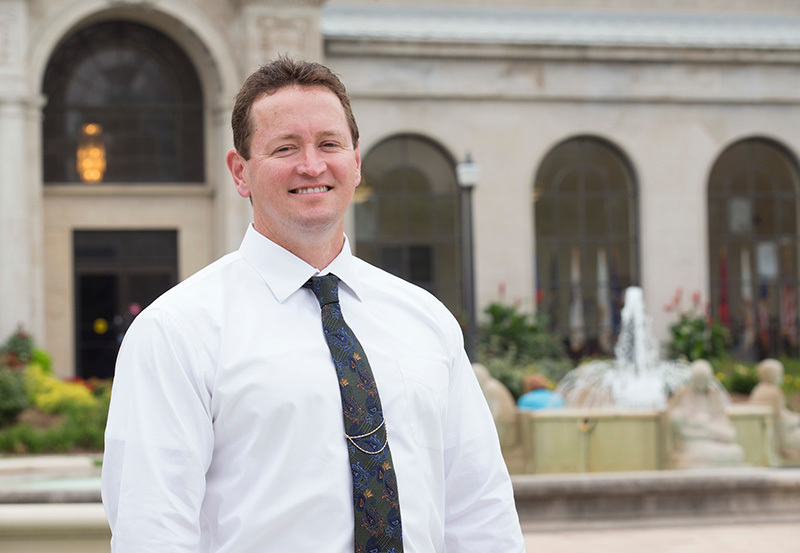
Memorial Union director Steve Winfrey arrived on campus this week. Photo by Christopher Gannon.
Steve Winfrey's (WIN-free) first day on campus as director of the Memorial Union was Aug. 14.
Winfrey will administer all MU facilities, programs, activities, products, services and tenant relations. He also will oversee the Student Activities Center. The MU director reports to senior vice president for student affairs Martino Harmon.
Winfrey comes to Iowa State from North Dakota State University, Fargo, where he served as director of the university's Memorial Union since 2007 and supervised the completion of a facility renovation and addition. Prior to working at NDSU, he was assistant director of leadership programs at the University of Minnesota, Minneapolis.
Winfrey's office is in 3644 Memorial Union. He can be reached by phone, 294-2300, or email, swinfrey@iastate.edu.
Related story
Winfrey named MU director, June 8, 2017
Quick look: Regent university five-year tuition proposals
Iowa's three public universities have proposed annual undergraduate tuition increases in the range of 1.75 to 11.7 percent during the next five years, in response to a state Board of Regents strategy to make the tuition-setting process predictable and stable for students and parents.
The two ends of the range are in Northern Iowa's proposal, which features three tuition scenarios based on possibilities for state operating support. The Iowa State and Iowa proposals feature a consistent annual increase for resident undergraduates (7 percent and 7.08 percent, respectively) and nonresident undergraduates (4 percent and 2.08 percent, respectively). Both of those proposals assume flat state operating support, and further cuts could alter their proposals, leaders said.
The universities presented their proposals at campus-based public forums Aug. 7-14. The four-member regents tuition task force will present a summary of the proposals and public comment to the full board at its Sept. 7 meeting in Iowa City. In October, the board will see tuition proposals for the 2018-19 year for the first time and vote on them at its December meeting.
Inside provides a summary of the three proposals.
Iowa State
Interim President Ben Allen told task force members Iowa State would use the additional revenue to maintain quality and scale key aspects of the university to begin to catch up with 10 years of enrollment growth. The four priority areas are: faculty and staff retention (salaries and salary increases), net growth of 330 tenure-eligible faculty as well as staff hires, 900,000 square feet of new building space and additional student financial aid.
Iowa State undergraduate tuition proposal
|
|
Fall 2018 |
Fall 2019 |
Fall 2020 |
Fall 2021 |
Fall 2022 |
|
Resident |
|
|
|
|
|
|
7% increase |
$522 |
$558 |
$598 |
$639 |
$684 |
|
Base tuition |
$7,978 |
$8,536 |
$9,134 |
$9,773 |
$10,457 |
|
Nonresident |
|
|
|
|
|
|
4% increase |
$852 |
$886 |
$921 |
$958 |
$996 |
|
Base tuition |
$22,144 |
$23,029 |
$23,951 |
$24,909 |
$25,905 |
Fall 2017 base tuition: Resident $7,456, nonresident $21,292
Iowa State assumptions:
- Flat state operating appropriations
- Flat enrollment
- Higher Education Price Index of 2.14 percent (inflationary consideration)
- Annual internal reallocations of 2.25 percent
University of Iowa
President Bruce Harreld told task force members his university is being "dramatically outspent" by its peers -- on average, almost $91 million in tuition and nearly $200 million in state support annually. He said additional revenue would be put toward an "excellence plan" to return the university "to the stature Iowans deserve." Specifics include hiring about 100 faculty and retaining the best faculty via competitive salary increases relative to peer schools; investments in both research and "high-impact" student opportunities such as internships and research team placements; and additional need-based and merit-based scholarships.
Harreld said a decision needs to be made: Either state government confirms that higher education is a public good and appropriates more money to the regent universities, or the universities are "allowed to compete with their peers and create the resources needed."
University of Iowa undergraduate tuition proposal
|
|
Fall 2018 |
Fall 2019 |
Fall 2020 |
Fall 2021 |
Fall 2022 |
|
Resident |
|
|
|
|
|
|
7.08% increase |
$530 |
$567 |
$607 |
$650 |
$696 |
|
Base tuition |
$8,016 |
$8,583 |
$9,191 |
$9,841 |
$10,537 |
|
Nonresident |
|
|
|
|
|
|
2.08% increase |
$606 |
$618 |
$631 |
$644 |
$658 |
|
Base tuition |
$29,736 |
$30,354 |
$30,986 |
$31,630 |
$32,288 |
Fall 2017 base tuition: Resident $7,486, nonresident $29,130
University of Iowa assumptions:
- Flat state operating appropriations
- Flat enrollment
University of Northern Iowa
Northern Iowa President Mark Nook said his university doesn't want to be on the same tuition trajectory as the other two regent schools.
"If we followed Iowa and Iowa State, we'd price ourselves out of our market," he said. While the board has identified a peer group for each of the universities, Nook said the group UNI most identifies with is like-sized schools in adjoining states.
He told the task force that additional revenue would support additional faculty and staff positions and additional student financial aid, in response to planned enrollment growth of about 450 students in five years.
Nook also noted that Northern Iowa's state support covers about half the cost of education, which is notably higher than the other two universities, where it's less than 30 percent this fall.
"Quality isn't tied to tuition revenue; it's tied to total revenue. We are subsidizing the cost of an education at UNI," Nook said.
Northern Iowa undergraduate resident tuition proposal
|
State funding level |
Fall 2018 |
Fall 2019 |
Fall 2020 |
Fall 2021 |
|
Increase of 1.75 percent/year |
3.9% |
2.7% |
1.75% |
1.75% |
|
Base tuition |
$7,747 |
$7,956 |
$8,095 |
$8,237 |
|
Flat each year |
6.7% |
5.2% |
3.7% |
3.1% |
|
Base tuition |
$7,955 |
$8,369 |
$8,679 |
$8,948 |
|
Repeats FY18's 3.2 percent reduction in FY19, then flat for 3 years |
11.7% |
4.9% |
3.5% |
2.9% |
|
Base tuition |
$8,328 |
$8,736 |
$9,042 |
$9,304 |
Fall 2017 base tuition: $7,457
Nook said the third scenario "is not a reasonable request" and would raise UNI tuition above all other schools in its comparison group except Illinois.
Northern Iowa assumptions:
- Growth in student body of 450 students (about 3.5 percent) by FY22, primarily nonresidents
- Hold expenses (employee salary and health care increases, maintenance) at FY08 levels adjusted for inflation (using the Consumer Price Index, not Higher Education Price Index)
A labor of love

Doug Harjes and Cheryl Robinette, groundskeepers in facilities planning and management, maintain the 2.7-acre university cemetery. Photos by Christopher Gannon.
ISU Cemetery
- Location: 2637 Pammel Dr. (north of Town Engineering, west of Communications)
- Established: 1876
- Presidents interred: Beardshear, Friley, Hilton, Knapp, Parks, Pearson, Welch
- Plot map
As groundskeepers in facilities planning and management, Doug Harjes and Cheryl Robinette are tasked with maintaining ISU's on-campus cemetery. However, it may be the people within the 1.7 acres of shaded grounds who receive the most care.
Harjes and Robinette agree that their work with one of the nation's few campus cemeteries is their favorite assignment as part of the campus services staff in facilities planning and management.
"It's just so peaceful here," Harjes said.
"We really love working here," Robinette said. "We can't work out here and not be touched. It makes you realize there's more than just coming to work. Here, there is the opportunity to meet people -- either from what's written on their headstones, or from people who come to visit and tell you stories about their family member."
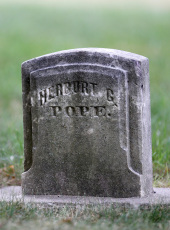
Herburt Pope, the son of the chemistry department chair, was the second burial in the cemetery. The first was Tom Lee Thompson, who died from pneumonia in 1875 while serving as a caretaker in the Old Main building.
More than a job
Established in 1875, the Iowa State cemetery serves as the final resting place for university presidents and others with names found on campus buildings and streets. But it's the lesser-known gravesites that pique the interest of Harjes and Robinette.
"You can't help but read the headstones when you're out here and then want to find out who the people are," Robinette said.
Their work is more than keeping the grounds mowed and weeded. It also includes burials -- on average, about 15-25 each year. They work with funeral homes to coordinate services (parking is scarce on weekdays during the school year), and with families who transport remains for interment.
Small ceremonies
"Usually, when you have a funeral here, there's hardly anybody," Harjes said. "It's the opposite of what we grew up experiencing -- when you went to the cemetery, there were 150 people. Here, there's seldom more than 10 or 15."
Harjes and Robinette attribute that to the uniqueness of a college cemetery and its eligibility requirements that help manage the limited available space. Memorials and services likely are held elsewhere.
"I think a lot of times, they may have moved away after they retired," Harjes said. "Their family may live [very far away]. A lot of times they have them cremated and mail them to us."
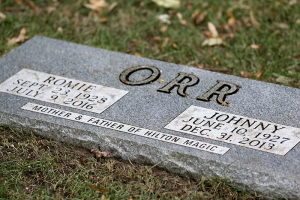
Former Cyclone basketball coach Johnny Orr and his wife, Romie, were interred in the cemetery.
The ultimate sacrifice
Harjes sometimes researches the names carved into headstones to find out more.
"Once in a while, especially if I know it's a military gravesite, I'll look up the obituary so I know more about the person and their service," he said. "I discovered brothers (Glen and Wayne Cunningham) who were buried next to each other and both died during World War II. I noticed the dates and ages and wrote their names down, then checked in the Gold Star Hall and they were in there."
He would like to find out if more veteran gravesites may have been overlooked.
"I thought that one day I would use the dates of World War I and look at the age of anyone that died in that era to see if they're in their 20s or 30s and narrow it down," he said.
This year for Memorial Day, Harjes and Robinette purchased large flags to denote the graves of the known war casualties buried there, including Lt. Harold Knight, who died while serving during WWII.
Storytellers
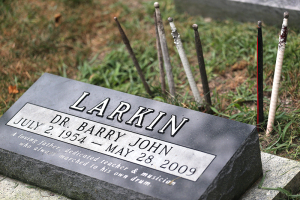
Each year, a visitor leaves a drumstick at the grave of former music faculty member Barry Larkin.
As Harjes and Robinette walk through the cemetery, they point to gravestones that spark their curiosity. They also share stories and anecdotes from their tenure as groundskeepers:
- A doe and her fawn watched as Harjes hand-dug a hole and buried cremains that had been shipped for burial. He called to let a family member know the ashes of her loved one had been buried and told them about the "visitors" who attended the burial. "I wanted her to know that maybe there's a higher power that's sending some love," Harjes said.
- As Harjes and Robinette stood by during a ceremony for a WWII veteran, a bald eagle soared overhead and perched in a tree above the site. "It was the craziest thing I'd ever seen," Harjes said. "That is one more example for me that there is a higher power out there."
- About a decade ago, the Ames police contacted area cemeteries to find the rightful home of a headstone found in an apartment, left in a closet for years. It was the marker for the grave of the infant grandson who preceded former president W. Robert Parks and his wife, Ellen, in death. After consulting with the family, the body and headstone were relocated. "We finally got him moved next to Grandma and Grandpa," Harjes said.
- Rather than leaving at the end of one ceremony, a family member asked if he could put a shovel of dirt onto the grave. "Then, the whole family -- even down to the little kids -- shoveled some dirt in there," Robinette said. "It was really sweet."
- Fresh flowers and plants don't last long, so Harjes and Robinette encourage families to take the arrangements home after the ceremony. "The deer usually come up and help themselves to that kind of stuff within a day or two," Harjes said. "I think the deer come up because they know there are fresh flowers."
- Some families will do a single ceremony for dual burials -- for example, interring the cremains of a husband and wife at the same time. Among the most recognizable are legendary Cyclone basketball coach Johnny Orr and his wife, Romie, who are buried together at the west end of the cemetery.
- Some visitors leave trinkets or items when they visit gravesites, ranging from miniature statues to rocks and golf balls. One visitor leaves a drumstick each year at the grave of former associate professor of music Barry Larkin. "We try not to move the things," Harjes said. "We leave it. It means something to someone."
In perpetuity
Both Harjes and Robinette joke (somewhat) that retirement won't stop their work at the cemetery.
"I always threaten that when I retire, I'll come back and volunteer my time here," Harjes said. "Then I can spend as much time as I want."
Summer 2017 in the rearview
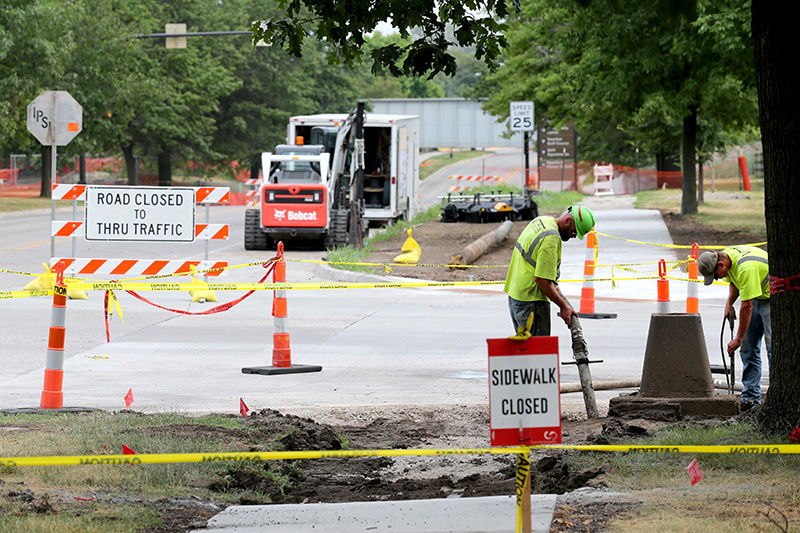
Orange cones and yellow caution tape were fixtures throughout campus this summer as crews worked to improve roads and sidewalks before the start of fall semester. Photo by Christopher Gannon.
Summer on college campuses typically is tranquil. But with a presidential search underway, buildings rising and falling, and new technology platforms launching, Iowa State was anything but quiet (except for the carillon) this summer. Here's a look at summer 2017 on campus.
New faces
- Paul Fuligni became associate vice president for facilities planning and management on July 10. He succeeded Dave Miller, who retired in January.
- Vernon Hurte, associate vice president and dean of students, joined Iowa State on July 3. He is responsible for 13 dean of students' units, including the office of international students and scholars.
- Deanna Clingan-Fischer became the university's first full-time ombuds officer on Aug. 7. Established in 2008, the ombuds office assists university employees with a variety of workplace challenges.
- Jim Reecy, professor of animal science and director of the office of biotechnology, was named associate vice president for research on June 1. He works with faculty and research leaders to develop interdisciplinary research opportunities and supports faculty with their research goals.
- Iowa State promoted two professors to academic leadership positions this summer. Bill Graves, professor of horticulture and former Graduate College associate dean, became dean of the Graduate College on July 17. Ann Marie VanDerZanden, professor of horticulture and former director of the Center for Excellence in Learning and Teaching (CELT), was named associate provost for academic affairs on July 19. Both roles were held by Dave Holger, who retired in June.
- Sara Marcketti, professor of apparel, events and hospitality management and CELT associate director, was appointed interim director of CELT on July 24.
- Surya Mallapragada, Distinguished Professor and Carol Vohs Johnson Chair in chemical and biological engineering, joined the office of the vice president for research on July 1 as a half-time associate vice president for research.
- Cory Harms, interim director of procurement services, was named director on Aug. 1.
- The search for an assistant vice president for business services was canceled following the identification of three finalists. Senior vice president for university services Kate Gregory is reevaluating the position before a new search. Norm Hill, director of logistics and support services, will continue as interim assistant VP.
- Two finalists were named for the new assistant vice president for student health services post. Heather Paris, ISU recreation services, and Caesar Ross, Coastal Carolina University, Conway, South Carolina, participated in open forums on campus earlier this month.
- Dave Roepke joined the university relations staff in June as a writer for Inside Iowa State.
Presidential search
- A 21-member presidential search committee held listening sessions with groups of Iowa State constituents in June to help determine the necessary characteristics and qualifications for the university's next president. Comments centered around upcoming challenges facing Iowa State, the future president's character and experience, and the strengths of the university and Ames.
- The search for a new Iowa State president was launched July 6. Application deadline is Aug. 24. Approximately eight to 12 semifinalists will interview in late September, and finalists are expected on campus for interviews the week of Oct. 9.
University human resources updates
- Iowa State launched a comprehensive classification and compensation review for professional and scientific staff early this summer. Employees submitted information about their positions in June using a job profile tool (JPT), followed by manager feedback and executive interviews. The JPT response rate was 76 percent. The review process will continue through fall 2018.
- Changes signed into law last February that govern collective bargaining rights for state employees took effect July 1, impacting approximately 1,300 Iowa State merit employees. Key changes include no seniority lists for job transfers, increased emphasis on performance evaluations and an adjustment in overtime calculations. Merit employees also will be phased into the ISU Plan for health benefits beginning Jan. 1, 2018.
Board of Regents decisions
- The state Board of Regents approved a second fall tuition increase of $216 per Iowa State student in June.
- The board approved in late June Iowa State's proposal to offer an on-campus bachelor's degree in nursing for registered nurses, beginning in fall 2018.
- Also in June, the board approved a new phased retirement policy that provides one- and two-year phased options. The new policy continues through June 2022.
- The board approved Iowa State's $722.9 million general fund budget earlier this month. The budget is 2 percent larger than last year's, with tuition and fees (63 percent) and state support (31 percent) making up most funding.
Construction roundup
- Of the many physical changes that took place on campus this summer, the carillon -- or lack of it -- may have garnered the most attention. Repair work in the bell chamber hushed the beloved icon beginning May 22. Other construction projects included work on numerous roads and parking lots, such as the underground utility project still underway. That work has closed the Pammel Drive/WOI Road intersection and parking lots north of the Communications and Molecular Biology buildings (lots 27, 28 and 29). The project will continue through October.
- Nuclear Engineering Laboratory and the southeast section of Sweeney Hall came down in May to make room for the new Student Innovation Center.
- Work to construct a plaza south of Jack Trice Stadium and transform a parking lot into green space near the entrance of Reiman Gardens kicked off in July. Thematic monuments and a low signage wall directing visitors to the gardens will be complete before the Sept. 2 Iowa State-Northern Iowa home football game.
- The G-Nomes on top of Molecular Biology returned at the end of July. The original sculptures, suffering from water damage, were removed earlier in the summer. The new structures are 400-pound aluminum replicas, built to last.
Information technology changes
- IT staff launched a website where the campus community can learn about and track the WorkCyte initiative – a move to university-wide (enterprise) technology platforms.
- After months of extensive review, Canvas was selected as Iowa State's new learning management system in June. Canvas replaces the existing Blackboard system, though Blackboard still will be available during fall semester. Canvas will be fully implemented next spring.
Finally, of note
- Iowa State's 2017 summer enrollment of 12,060 students exceeded last summer's record by 118 students. Nearly one-third of those students were enrolled only in online courses, a 15 percent increase over last year.
- Iowa State received more than $500 million in external funding in FY17, breaking the previous record of $425.8 million set in FY16. The increase was partly due to a $93 million gift to the ISU Foundation, which benefits the College of Liberal Arts and Sciences.
- Gov. Branstad signed a bill on May 12 that eliminated state funding for the Leopold Center, but he did not mandate the center's closure. A series of listening sessions to hear ideas for the center's future and direction are underway across the state. All sessions are free and open to the public.
- Ames police will enforce time restrictions on street parking in residential neighborhoods south and west of campus beginning this fall. The city intends to hire additional part-time community safety officers to help with the patrolling.
- Phase 1 of a Lincoln Way safety study (between Sheldon Avenue and University Boulevard) found few issues with the street itself. Instead, the study exposed problems with pedestrian behavior. Phase 2 of the study will focus on ways to improve safety on Iowa State's stretch of Lincoln Way, such as altering the timing of traffic signals and developing an education campaign for pedestrians.
PeopleAdmin training is online at Learn@ISU
Learn@ISU: One-stop training shop
Learn@ISU, Iowa State's online learning management portal, was launched in 2015. It allows employees to take online courses or register for face-to-face training sessions sponsored by numerous ISU departments and units, including the Center for Excellence in Learning and Teaching, environmental health and safety, university human resources, library, procurement and more. For additional information, visit Learn@ISU, log in with your ISU Net-ID and password and search the desired course catalog.
Training for PeopleAdmin 7, Iowa State's online classification and hiring system, no longer requires face-to-face classroom sessions. Employees involved in the hiring process now may learn about PeopleAdmin using on-demand training courses on Learn@ISU.
UHR leaders determined online PeopleAdmin courses are more efficient for those involved in the hiring process. They also think it will help increase training participation.
"Some departments hire once a year, and they don't remember how to use the system. Instead of waiting for in-person training to take place, they can watch the on-demand training when it's time to hire," said Dana Rasmussen, human resources manager in talent acquisition. "Also, we weren't getting a lot of attendance for the in-person trainings because they didn't have time to sit through a three-hour session. Now that we've broken them down, people can watch them any time."
Rasmussen estimates each training module lasts about 10 minutes. To watch them all at one time would take about 60 minutes.
The new courses, their descriptions and intended audiences are:
|
Course name |
What's it about? |
Who should participate? |
|
Position Management |
Learn to create, update or reclassify a position description (PD) |
All employee groups, hiring manager, department chair/director, dean/assistant VP, president/senior VP |
|
Writing a Position Description (PD) |
Discusses the content necessary to complete a PD |
All employee groups, hiring manager, department chair/director, dean/assistant VP, president/senior VP |
|
Creating a Posting |
Learn to create a posting for positions that do not require a position description. This includes faculty, postdocs, contract, professional and scientific temporary (XH), professional and scientific emergency and merit temporary (XH). Individuals who have posting admin user access are encouraged to attend. |
Posting administrator or proxy for the following: Department chair/director, dean/assistant VP, president/senior VP |
|
Managing Applicants |
Covers the process of how to rate applicants and route them for interview approval. Individuals who have posting admin access are encouraged to attend. |
Posting administrator or proxy for the following: Department chair/director, dean/assistant VP, president/senior VP |
|
Initiating and Completing a Hiring Proposal |
Describes the three-step hiring proposal process for all employment types. The process includes routing a hiring proposal for approval, creating an electronic letter of intent (eLOI) and completing the hiring proposal to initiate an electronic personnel action (EPA). |
Posting administrator or proxy for the following: Department chair/director, dean/assistant VP, president/senior VP |
More resources
Additional PeopleAdmin resources, including online videos, quick reference guides and job aids, are available on the PeopleAdmin training website.
For more information about PeopleAdmin and the new online training courses, contact UHR at hrshelp@iastate.edu.
Last chance
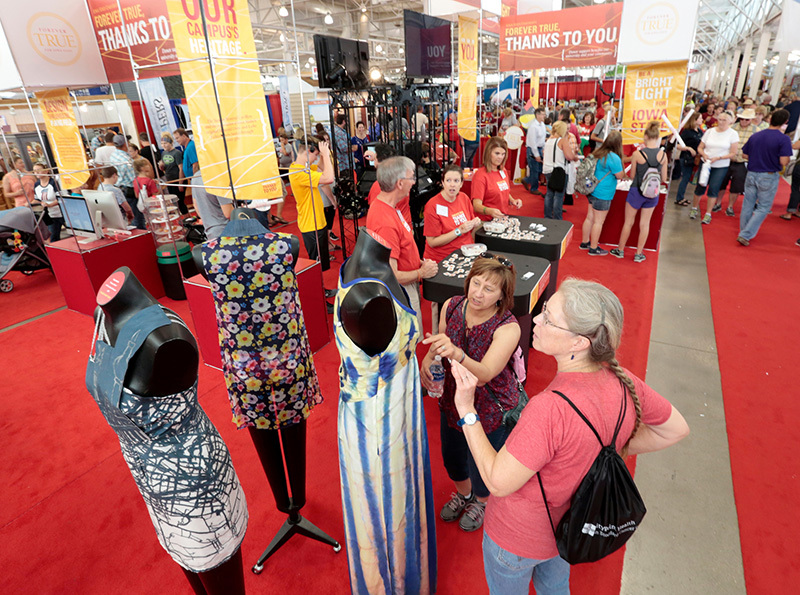
Photo by Christopher Gannon.
Gloria Tesdell (right) and Berta Hemmstra, both of Urbandale, look over student-designed garments from the spring Fashion Show and now featured in the university's exhibit at the Iowa State Fair.
The Fair runs through Sunday, Aug. 20 (7 a.m.-1 a.m. daily, buildings open 9 a.m.-9 p.m.). If you go, be sure to include a stop at the Iowa State exhibit in the Varied Industries Building.
